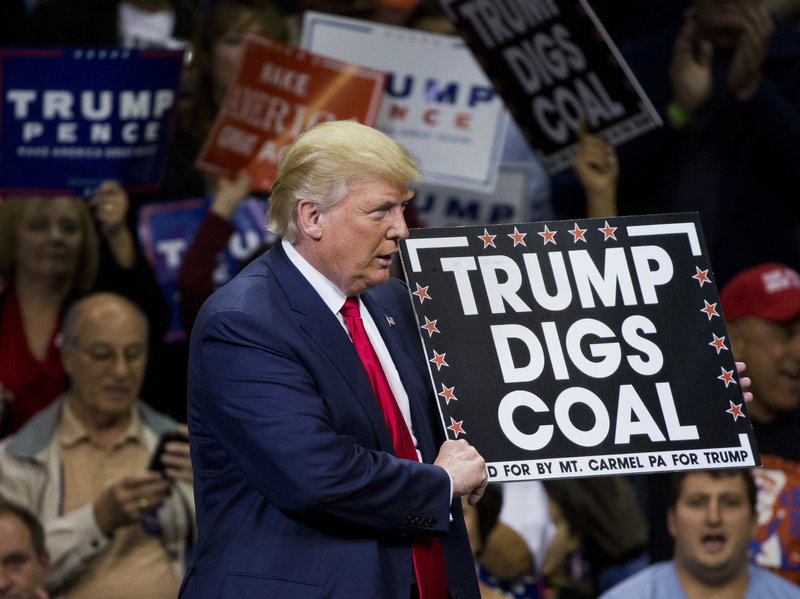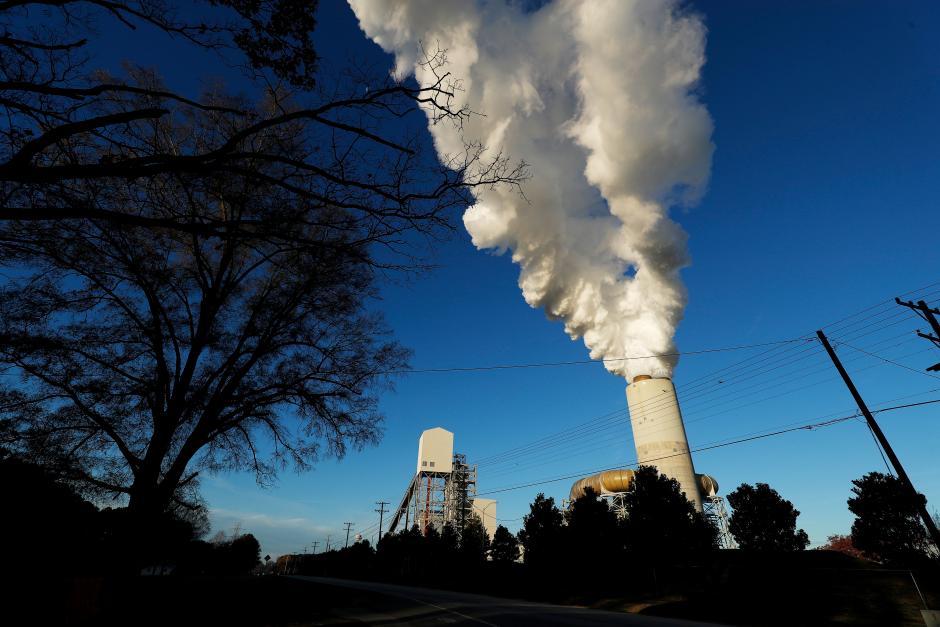U.S. Limits on Coal Plant Mercury Emissions Too Costly: Trump’s EPA
ENVIRONMENT, 31 Dec 2018
Humeyra Pamuk | Reuters – TRANSCEND Media Service
28 Dec 2018 – The Trump administration today said limits on mercury emissions from coal-fired power plants were unnecessary as they were too costly, sparking an outcry from environmentalists who feared the next step would be looser rules favoring the coal industry at the expense of public health.
Under the Mercury and Air Toxic Standards, or MATS, enacted under former President Barack Obama, coal-burning power plants were required to install expensive equipment to cut output of mercury, which can harm pregnant women and put infants and children at risk of developmental problems.

President-elect Donald Trump’s promises to bring back miner jobs and open mines appealed to many voters in coal country.
Dominick Reuter/AFP/Getty Images
The Environmental Protection Agency left the 2011 emission standards in place but proposed using a different cost analysis to evaluate whether the regulation is needed, a move that paves the way for looser rules going forward. Its statement was issued on Friday during a partial government shutdown.
Since August, the Environmental Protection Agency has been reconsidering the justification for the rule. A coalition of electric utilities had said the looser rules were not needed since they have already invested billions of dollars in technology to cut emissions of the pollutant and comply.
EPA said it was “proposing that it is not ‘appropriate and necessary’ to regulate HAP (Hazardous Air Pollution) emissions from coal- and oil-fired power plants… because the costs of such regulation grossly outweigh the quantified HAP benefits.”
It said its reassessment showed the cost of compliance with MATS was between $7.4 billion to $9.6 billion annually, while the monetized benefits were between $4 million to $6 million.
It also said the identification of unquantified benefits was not enough to support the standards. Among such benefits, environmentalists say are reduced healthcare costs, breathing cleaner air and drinking cleaner water.
“The policy (Acting EPA Administrator) Andrew Wheeler and (President) Donald Trump proposed today means more pregnant women, young children, and the elderly will be exposed to deadly neurotoxins and poisons, just so wealthy coal and oil barons can make a few extra bucks,” Sierra Club Beyond Coal Campaign Director Mary Anne Hitt said in a statement. Wheeler is a former coal industry lobbyist.
“Virtually every coal plant in the U.S. has already met this lifesaving standard, and now Trump is recklessly trying to roll it back,” she said.
A study published this month by Harvard University’s School of Public Health said coal-fired power plants are the top source of mercury in the United States, accounting for nearly half of mercury emissions in 2015. It said the standards have markedly reduced mercury in the environment and improved public health.

FILE PHOTO: A view of Duke Energy’s Marshall Power Plant in Sherrills Ford, North Carolina, U.S. November 29, 2018. REUTERS/Chris Keane/File Photo
‘Please Stop Helping’
Since taking office in January 2017, Trump has targeted rolling back Obama-era environmental and climate protections to maximize production of domestic fossil fuels, including crude oil. U.S. oil production is the highest in the world, above Saudi Arabia and Russia, after a boom that was triggered more than a decade ago by improved drilling technology.
The coal industry had challenged a 2016 conclusion by Obama’s EPA that the rule was justified because savings to U.S. consumers on healthcare costs would exceed compliance costs. The calculations accounted for how pollution-control equipment would reduce emissions of other harmful substances in addition to mercury.
Trump’s industry allies, including Robert Murray, CEO of private coal mining giant Murray Energy Corp, had complained that the MATS rule contributed to the demise of the coal business by triggering hundreds of coal-fired power plant shutdowns and driving coal demand to its lowest in decades.
U.S. coal-fired power generation has fallen more than 40percent since a peak in 2007, while natural gas-fired generation soared by about the same amount, according to the EnergyInformation Administration.
Utilities’ demand for U.S. coal is projected to fall further this year, by around 2.5 percent to 648.2 million short tons, the lowest in 35 years, according to the EIA.
In July, electric utilities and utility groups favoring the rule asked the administration to keep it in place. They noted that billions of dollars in investments for anti-pollution equipment have already been made, and costs are being recovered from electricity customers through regulated pricing.
“This is like when your four-year-old kid tries to clean up your kitchen – it actually makes things worse. Please stop helping,” said a utility industry lobbyist based in Washington, who asked not to be named. “The rule itself forced coal plant shutdowns, but they aren’t coming back.”
EPA said it will take comment for the proposal for 60 days and will hold at least one public hearing.
________________________________________________
Additional reporting by Richard Valdmanis; Editing by David Gregorio
DISCLAIMER: The statements, views and opinions expressed in pieces republished here are solely those of the authors and do not necessarily represent those of TMS. In accordance with title 17 U.S.C. section 107, this material is distributed without profit to those who have expressed a prior interest in receiving the included information for research and educational purposes. TMS has no affiliation whatsoever with the originator of this article nor is TMS endorsed or sponsored by the originator. “GO TO ORIGINAL” links are provided as a convenience to our readers and allow for verification of authenticity. However, as originating pages are often updated by their originating host sites, the versions posted may not match the versions our readers view when clicking the “GO TO ORIGINAL” links. This site contains copyrighted material the use of which has not always been specifically authorized by the copyright owner. We are making such material available in our efforts to advance understanding of environmental, political, human rights, economic, democracy, scientific, and social justice issues, etc. We believe this constitutes a ‘fair use’ of any such copyrighted material as provided for in section 107 of the US Copyright Law. In accordance with Title 17 U.S.C. Section 107, the material on this site is distributed without profit to those who have expressed a prior interest in receiving the included information for research and educational purposes. For more information go to: http://www.law.cornell.edu/uscode/17/107.shtml. If you wish to use copyrighted material from this site for purposes of your own that go beyond ‘fair use’, you must obtain permission from the copyright owner.